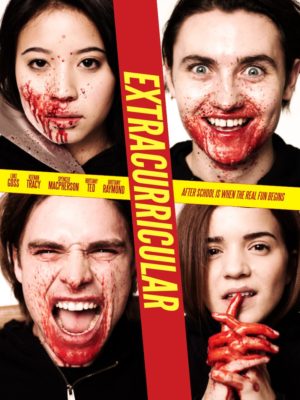
Ray Xue’s feature directorial debut, Extracurricular has a solid hook: the film is about a group of sociopathic teens who casually plan and execute murders in between College applications, book reports and dance recitals. Following in the footsteps of last year’s festival hit Tragedy Girls (albeit in less satirical fashion), Extracurricular aims to be shocking and topical but winds up missing the mark, despite confident direction by Xue and dedicated performances by the young cast.
The film opens solidly with a double murder right off the top. After a brief introduction, a pair of twenty-something lovebirds are awoken by the sound of their car alarm in the middle of the night. The man goes to investigate and never returns, leaving his girlfriend to discover his mutilated body outside and a group of neon-masked villains lining the driveway. After a brief chase, the woman is also dispatched by The Purge-like killers.
There’s no mystery about the identity of the murderers: the very next scene finds a foursome of teens chatting animatedly in a diner about what they felt worked and what didn’t. Aggressive leader Ian Gordon (Spencer Macpherson) is a nihilist, while his long haired brother Derek (Keenan Tracey) is flippant and casual. Derek’s girlfriend Jenny (Brittany Teo) initially presents as a little princess-y (she complains about the outdoor murder location), but is quickly revealed to be the most ambitious and murder-focused member of the group. Circling the periphery is defacto protagonist (or is it anti-hero?) Miriam (Brittany Raymond), who is detail-oriented but cautious.
Following the murders, writers Matthew Abrams and Padgett Arango slow things down. We see the foursome at school, where they’re revealed to be popular, scholastic, and involved in social activities. They just so happen to also use study period to plan future murders and survey social media for news of their extracurricular exploits. Abrams and Arango never quite nail the tone of the film, so it is unclear if audiences are meant to cheer for these murderous teens or condemn their psychopathic tendencies. There’s a suggestion that their boredom, the small town they live in and a lack of parental supervision has contributed to their development, but these ideas are never fully explored.
And therein lies Extracurricular‘s greatest problem. The script is poorly constructed, which hampers the film to such a degree that even its strengths can overcome the writing deficiencies.
While there are no hard and fast screenwriting rules that must be obeyed, there are several near-universal screenwriting techniques that successful writers use. And for a good reason: they work.
Abrams and Arango adhere to a fairly traditional structure for the first hour or so of the film, and then they make the ill-advised decision to abandon their course of action in favour of a series of unexpected – and unsatisfying – narrative developments. This proves to be their — and the film’s — undoing.
The most grievous mistake they make is asking the audience to invest in characters without paying that investment off. If, for example, the vast majority of the film is centered around one character, the audience is likely going to assume that individual is your protagonist. If this character is given a love interest and a promising story arc, the audience will expect these elements to amount to something. If other characters are given backstories about absent or fractured relationships with their parents, this information might be seen by audiences as relevant to the story’s outcome.
Unfortunately this is not the case with Extracurricular, which introduces all of these components, then fails to address them or pay them off. And while this may seem like a daring or risqué inversion of audience expectations in an attempt to do something unique and out of the box, the reality is that most of the climax feels out of the blue, undercooked and, unfortunately, quite unsatisfying.

This is a shame because Xue’s direction is solid. He has a good understanding of how to light and shoot kill sequences, alternating between jerky handheld action and steadicam long shots. There’s also a sense of experimentation in the way he uses the camera, such as his slow 360 degree pan around the room in a scene when the group discusses which mask to wear for a Halloween kill. Traditional cutting would have sufficed, but the circular motion is more engaging and reinforces the meandering nature of their conversation.
The young cast is also extremely game, particularly Teo and Raymond. As the not-so-secret sadist, Teo is frighteningly efficient — what may be a strange hobby for the others comes off as a vocation to Jenny. Raymond, meanwhile, has the most meaty material to work with; Miriam is not only the most apprehensive member of the group, she is negotiating her burgeoning feelings for a classmate, videographer Layla (Shanel Maida). The chemistry between the pair is appropriately romantic, particularly in the dreamy sequences when Layla films Miriam dancing for her College application. Miriam’s slow drift away from her homicidal friends is Extracurricular‘s most engaging storyline, which only makes it all the more frustrating when Abrams and Arango abandon it in favour of a series of twist endings.
Sadly, despite strong direction and dedicated performances by the cast, the film is undone by poor scripting decisions. There’s a kernel of something great here, but Extracurricular ultimately fails the written.
2/5